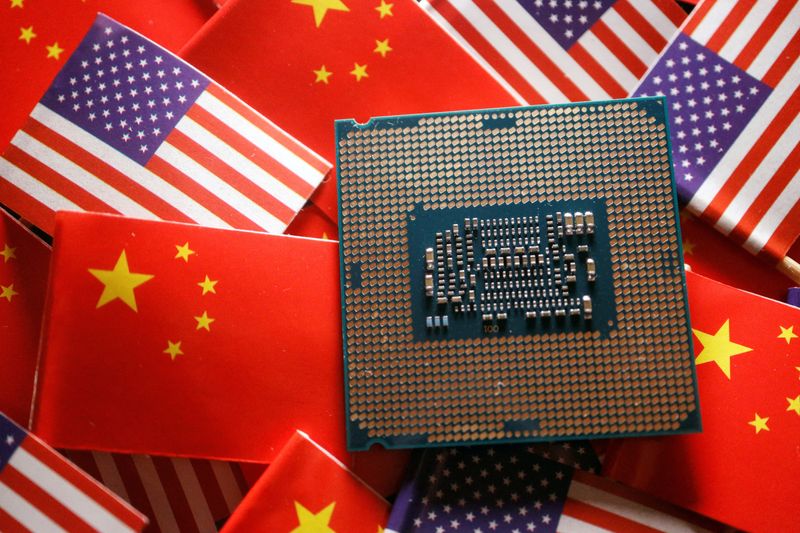(This July 4 story has been refiled to specify data on gallium is for primary gallium only in paragraph 12 and add Canadian gallium producer in paragraph 8)
(Reuters) - China said on Monday it will impose export restrictions from Aug. 1 on some gallium and germanium products, metals used in computer chips and other products, to protect national security interests.
Here are some facts about gallium and germanium:
WHERE IS GERMANIUM FOUND?
Germanium ores are rare and most germanium is a by-product of zinc production and from coal fly ash.
China produces around 60% of the world's germanium, according to European industry association Critical Raw Materials Alliance (CRMA), with the rest coming from Canada, Finland, Russia and the United States.
China exported 43.7 metric tons of unwrought and wrought germanium last year, according to Chinese customs.
Roughly $39 million worth of germanium was consumed last year, up 10% from 2021, according to the U.S. Geological Survey (USGS).
WHAT ABOUT GALLIUM?
Gallium is found in trace amounts in zinc ores and in bauxite, and gallium metal is produced when processing bauxite to make aluminium. Around 80% is produced in China, according to the CRMA.
Gallium is used to make gallium arsenide for use in electronics. Only a few companies - one in Europe and the rest in Japan and China - can make it at the required purity, says the CRMA. Canadian company Neo Performance Materials said it also makes gallium at the required purity.
China exported 94 metric tons of gallium in 2022, up 25% on the prior year, according to Chinese customs.
U.S. imports of gallium metal and gallium arsenide (GaAs) wafers in 2022 were worth about $3 million and $200 million, respectively, according to USGS.
According to USGS, high-purity refined gallium production last year was estimated at about 290,000 kgs, a 16% increase from 250,000 kgs in 2021.
WHO ELSE PRODUCES THESE METALS?
Small amounts of primary gallium - around 10 metric tons in 2021 - are produced by Japan, Russia and South Korea, according to USGS, while additional amounts also come from recycled material.
Germany and Kazakhstan also produced it in the past. After prices rallied in 2020 and 2021, Germany announced that it would restart primary gallium production.
Canada's Teck Resources (NYSE:TECK) is the biggest germanium producer in North America, extracting the material from its Trail smelter in British Columbia.
U.S.-based Indium Corporation also produces germanium, while Belgium's Umicore makes both germanium and gallium.
WHAT ARE THEY USED FOR?
The metals are used in high-speed computer chips and in the defence and renewable energy sectors.
Germanium is key to fibre optic cables and also used in high-speed computer chips and plastics as well as infrared radiation.
The metal and its oxides are used in military applications like night-vision devices as well as satellite imagery sensors.
It is also important for low-carbon technologies such as solar cells.
Semiconductor wafers made with gallium arsenide rather than silicon can operate at higher frequencies and are heat resistant, according to U.S. company Wafer World.
They also produce less noise than silicon devices, especially at high operating frequencies, making them useful in radars and radio communication devices, satellites and LEDs, Wafer World says.
SUBSTITUTES?
In some applications, gallium in arsenide wafers can replaced by silicon or indium, according to USGS.
"Silicon can be a less-expensive substitute for germanium in certain electronic applications," according to USGS.
"Zinc selenide and germanium glass substitute for germanium metal in infrared applications systems, but often at the expense of performance."
HOW MUCH DO THEY COST?
Gallium at 99.99% purity in China was assessed at 1,775 yuan ($245) a kg on Monday, up 5.97% from the previous session and the highest since May 16, Shanghai Metal Exchange data on Refinitiv Eikon showed.
China's germanium ingot price was last at 9,150 yuan ($1,264) per kg on Monday, Shanghai Metal Exchange data on Refinitiv Eikon showed.
IS THERE A PRECEDENT?
In 2010, China restricted export quotas of rare earths to Japan following a territorial dispute between the countries, sending prices of rare earths soaring and Japan scrambling to find other sources of supply. Beijing said at the time the curbs were based on environmental concerns.
Rare earth magnets are used in wind turbines, electric vehicles and defence applications like laser guided missiles.

China has hinted at various times that it could crimp rare earths exports, including in recent years.
($1 = 7.2374 yuan)